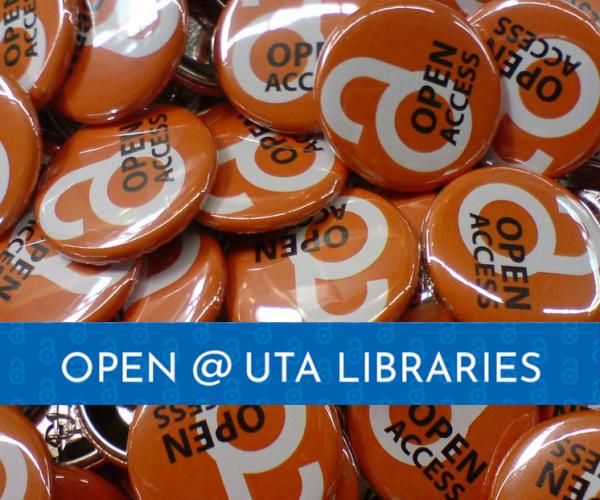
What is Open @ UTA Libraries?
This is the first post in a new series on the UTA Libraries blog, entitled “Open @ UTA Libraries.” “Open” is a buzzy word in higher education that we hear in many contexts: open pedagogy, open science, open access, open data, open educational resources. This series aims to elucidate these terms and connect them to the work that is being done at the UTA Libraries, across campus, and around the world.
What does it mean to be “open”?
The Open Movement is a global initiative focused on increasing equitable access to information, resource sharing, and collaboration. As a result, "open” as a descriptor can be applied to a variety of scholarly, research, and creative outcomes. The Open Knowledge Foundation defines “open” like this: “Open data and content can be freely used, modified, and shared by anyone for any purpose.” An open resource is made available to all users at no cost—typically online in a digital format—with additional usage permissions granted to the user by the author and/or copyright holder. While the copyright holder does retain some rights, most open content is given a license that allows users permission to reuse, retain, remix, revise, and/or redistribute the work. We call these five permissions the 5 Rs.
While the broader Open Movement shares a similar mission, there are initiatives within the movement that have more focused objectives:
Open access grew in popularity in the 1990s as publishers began to increase subscription costs for scholarly journals. Libraries pay these costs for the benefit of their patrons/students. In university libraries, those costs are ultimately paid by students, through their tuition fees. Open access publishing options make scholarly research available for free, and many journals also apply an open license that allows for modification. In addition, most open access publishing ensures that the authors retain their rights to their intellectual property, unlike in traditional for-profit scholarly publishing. Instead of charging for subscriptions, publishers have shifted costs to authors, requiring Article Processing Charges (APCs) for a work to be published open access. Many universities like UTA support authors by providing funding for APCs.
Open source was also a term defined in the 1990s, referring to the practice of making software source code available for others to access, reuse, and modify. More recently, sites like Github allow coders to share their work and contribute to other projects. Unlike other open movements described here, open-source software uses its own licenses instead of the Creative Commons licenses commonly used in publishing. Many students engage with open-source code as they learn coding skills.
Students often cannot afford required textbooks and, therefore, cannot engage completely with course content. As educators worked to address this issue in the late 1990s, academic David Wiley first used the term open educational resources (OER). OER are openly licensed materials used for teaching and learning, used not only to make course materials more affordable but also to create tailored and localized instructional tools. In 2017, Texas Senate Bill 810 established a statewide program supporting OER adoption and creation and also outlined requirements for transparency in higher education course materials costs. In the past decade, instructors have turned to open pedagogy as a method of increasing student success. Open pedagogy is an approach that encourages students to engage more deeply with open course materials and often results in new resources, with contributions from students, that can be published with an open license.
Open data and open science are two areas that are growing in interest among global researchers. These ideas go beyond open access, which provides free access to results, by calling for researchers to share previously restricted content like data, notes, and methods. In 2022, the White House Office of Science and Technology Policy issued a mandate that all federally funded research (including data) must be made available for free immediately upon completion. Scientific research benefits society when it is accessible in a timely manner and when it is really needed.
Open @ UTA Libraries
At the UTA Libraries, the concept of “open” is woven throughout the work we do. Some departments are clear leaders in this work because they have “open” in their names (Open Educational Resources, Open Partnerships & Services), but colleagues across the Libraries contribute to open initiatives and programs (Access & Discovery, Experiential Learning, Special Collections and Archives, and many others).
Some of the open initiatives we support include:
-
Publishing open access journals and open educational resources through Mavs Open Press
-
Preserving and publishing scholarly content in the UTA ResearchCommons, including all graduate theses and dissertations produced at UTA
-
Hosting programming and events around Open Education Week and Open Access Week
-
Partnering with publishers for open access agreements
-
Supporting open projects on accessible platforms and through library grant programs
The Open @ UTA Libraries blog series will allow the UTA Libraries staff to share information about the great work we do in pursuit of open. Team members from OPS, OER, A&D, and other departments will post about accomplishments, upcoming initiatives, and topics related to the open movement. Posts will be uploaded to the blog every other Tuesday. Get in touch if you have questions or have a partnership in mind! We look forward to working with you!
The cover image for this blog post is "Open Access Buttons with Banner" by Jessica McClean, licensed CC BY-SA 2.0. It is a derivative of "Open Access Buttons" by h_pampel, licensed under CC BY-SA 2.0, and was modified to add the "Open @ UTA Libraries" banner.

Comments
NICE!
This work is so important and I'm so pleased to be a colleague of all these great folks!
Great overview!
Great overview!
Add new comment